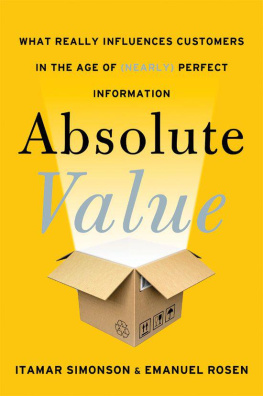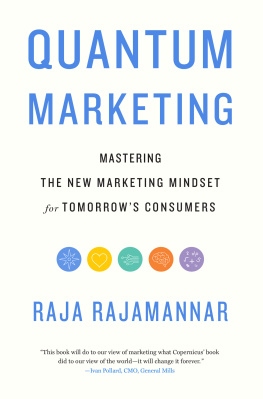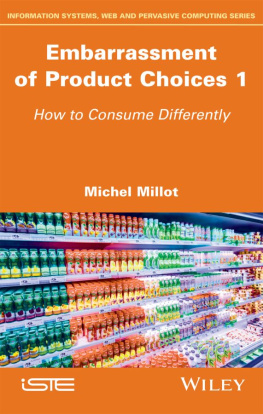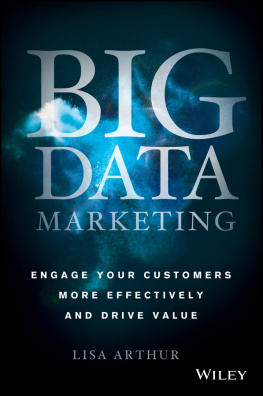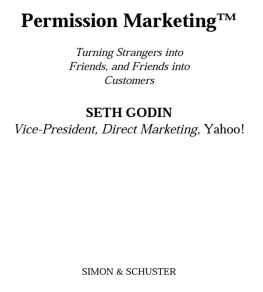To Yael and Daria,
for your absolute support
CONTENTS
HERE ARE FIVE widely held beliefs about marketing and decision making that we collected from recent publications. This book explains why these (and other) statements are becoming less true today, and why they are likely to be even less true in the future:
A companys brand is more important today than it has ever been.
Nurturing loyalty should be the marketers primary, day-to-day concern.
All customers are irrational.
An overload of options may actually paralyze people.
Positioning is the most important part of the marketing game.
Why do we think that these mantras will become less relevant? Our answer is rooted in a fundamental shift in consumer decision making: Consumers used to make decisions relative to other thingsa brand name, their previous experience with a company, an inflated list price, a brands advertising message compared to competing brands messages, or the other products a marketer chose to display on a catalog page or on the shelf. Conventional wisdom still holds that peoples choices can be greatly influenced by the context or the framing of an offer.
But for the first time this is starting to change and were moving toward an age of nearly perfect information. Review sites, shopping apps on smartphones, an extended network of acquaintances available through social media, and unprecedented access to experts and other sources, all mean that many consumers today operate in a radically different, socially intensive information environment. In a world where consumers enjoy complete access to informed experts and various information services, where they can instantly read the opinions of previous users, its much easier for consumers to predict their likely experience with a product or a serviceits easier to know the absolute value of things.
When we talk about absolute value we refer to the experienced quality of a product. For example, the experience at a restaurant, the pleasure (or boredom) one might experience reading a book, the closeness of the shave, the actual comfort of headphones, or the usage value you get from using your camera. So absolute value doesnt only refer to the technical specifications and reliability of a camera, but to what it is like to own and actually use it. In short: The new information environment around us allows consumers to predict much more accurately the experienced quality (or absolute value) of products and services they consider getting.
The implications for consumers and businesses are enormous. First, reliance on absolute values means that, on average, consumers tend to make better decisions and become less susceptible to context or framing manipulations. For businesses it means that marketing is changing forever. When consumers can more easily assess absolute values, this means that the influence of relative forces (such as branding, loyalty, and positioning) that used to drive predictions of the experienced quality of things is, for numerous products and services, rapidly declining.
The fundamental shift from relative to absolute requires managers, marketers, and business strategists to reexamine everything , and it gives rise to the need for a new way of thinking about marketing (and for a new language to talk about it). This is why we offer an entirely new framework (which we call the Influence Mix) for making more effective marketing decisions based on the mix of influence sources that your customers rely on. The reality is that the shift from relative to absolute is taking place in some product categories and for some consumers much faster than for others. This framework will let marketers better understand where things are changing and where they are not, and apply the marketing strategies and programs that are appropriate in each case.
Our agent, Jim Levine, always likes to say that a good business book should address three questions: 1) What? 2) So what? and 3) Now what? We can summarize everything we said so far by answering these questions: What? Theres a fundamental shift in consumer decision making. Instead of relying on relative evaluations, for the first time in history consumers have the tools to assess the absolute value of things. So what? This means that consumers are likely to make better decisions (on average) and that marketing is changing forever because people will rely less on proxies for quality such as brand names, loyalty, or positioning. Now what? All this gives rise to the need for a new framework and approach to marketing, which we call the Influence Mix.
To help you navigate through our book, we divided it into three sections which (more or less) correspond to the three questions above. In Part I A Shift from Relative to Absolute we establish the foundation. In Chapter 1 we show how a company can benefit from the shift: Since brand names play a reduced role as proxies for quality, ASUS was able to reach the fifth place in worldwide PC shipments without heavily investing in building its brand. Of course, well go deeper into the theory (and will present some experimental evidence) regarding the shift away from relative evaluations in todays shopping environment. In Chapter 2, we explain why some of the key demonstrations of irrational consumer decisions are becoming less relevant. We all have been flooded with books and articles about how irrational we are, but the new information environment actually allows us to make better choices overall that are based on absolute valuesthe building blocks of effective decisions. Weve also heard a lot in recent years about choice overloadthe notion that we are overwhelmed by too many choicesbut in Chapter 3 we question the robustness of this notion. Using a variety of information search aides, most consumers can handle the available information selectively and efficiently; we also describe some new patterns in decision making that emerge in the age of abundant, low-cost information. In Chapter 4 we address a question that some readers may have on their minds: With the constant trickle of stories in the media about fake reviews and other attempts to game the system, why are we still bullish about absolute values?
In Part II How Marketing Changes Forever we describe previously unrecognized implications of the current environment for business, marketing practice, and consumer decision making. In Chapter 5 we explain why brands are losing their role as proxies for quality. We explore, for example, how Yelp affected the revenues of big chain restaurants, and the opportunities it opens to other businesses. In Chapter 6 we explore the topic of loyalty and satisfaction. When consumers rely on absolute values and less on their past experience, loyalty declines. What are the implications to business? You can never rest on your laurels (think Nokia or BlackBerry), but it also opens some opportunities. In Chapter 7 we discuss how some theories of diffusion are changing when uncertainty about innovations is resolved much faster than in the past. Well discuss, for example, how Pinterest defied the traditional thinking about technology adoption in Silicon Valley. Then, in Chapter 8 we argue that when its easier to assess absolute values, positioning and persuasion techniques are likely to become less effective. (In the old days, Volvo could position itself as the safest car. Its much harder to do when customers use different information sources.)
In Part III A New Framework we introduce the Influence Mix, which should help managers determine where their products fall with respect to the evolving customer decision making. As we explain in Chapter 9, there are categories, segments, and situations where consumers still heavily depend on relative evaluations (while absolute values drive the choice of a new camera, brand names and habits continue to be key drivers in choices of beer). Once a company determines the mix of sources that influence its customers, that mix should drive their strategy. This applies to its communication strategy (which we discuss in Chapter 10) and its market research program (the subject of Chapter 11), and it can also differ by segment (which we cover in Chapter 12). Throughout this section we emphasize that the Influence Mix is dynamic. A segment that is currently influenced by traditional information sources can move to new sources rather quickly. This is particularly true as new sorting and search tools (which are even easier to use than existing ones) will keep emerging, which is the topic of Chapter 13. Then, in Chapter 14 we make some final comments about the shape of things to come and illustrate how particular managerial practices such as pricing or organizational structure might be revised to fit the new reality.

